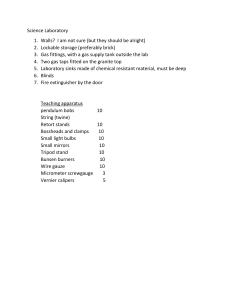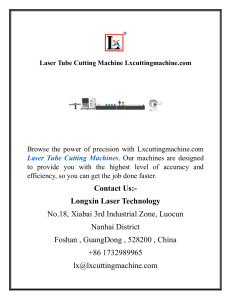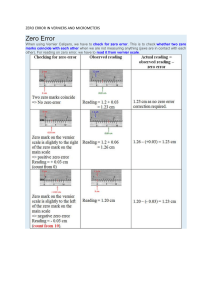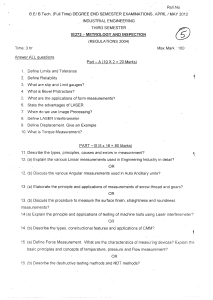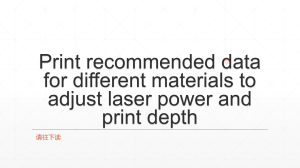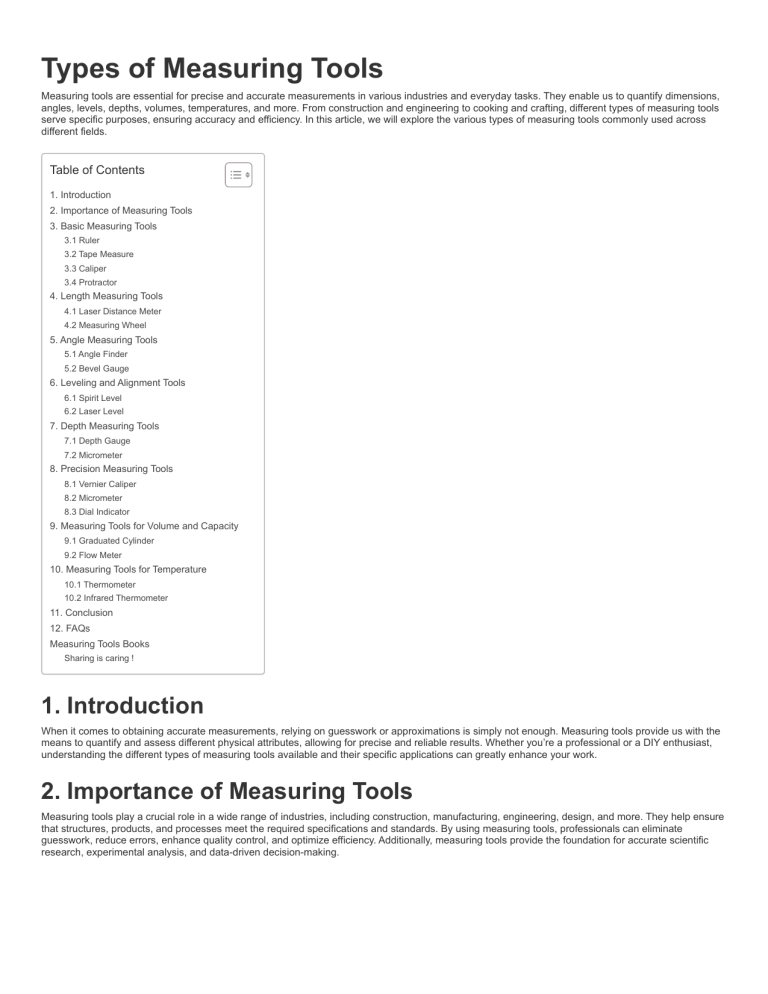
Types of Measuring Tools Measuring tools are essential for precise and accurate measurements in various industries and everyday tasks. They enable us to quantify dimensions, angles, levels, depths, volumes, temperatures, and more. From construction and engineering to cooking and crafting, different types of measuring tools serve specific purposes, ensuring accuracy and efficiency. In this article, we will explore the various types of measuring tools commonly used across different fields. Table of Contents 1. Introduction 2. Importance of Measuring Tools 3. Basic Measuring Tools 3.1 Ruler 3.2 Tape Measure 3.3 Caliper 3.4 Protractor 4. Length Measuring Tools 4.1 Laser Distance Meter 4.2 Measuring Wheel 5. Angle Measuring Tools 5.1 Angle Finder 5.2 Bevel Gauge 6. Leveling and Alignment Tools 6.1 Spirit Level 6.2 Laser Level 7. Depth Measuring Tools 7.1 Depth Gauge 7.2 Micrometer 8. Precision Measuring Tools 8.1 Vernier Caliper 8.2 Micrometer 8.3 Dial Indicator 9. Measuring Tools for Volume and Capacity 9.1 Graduated Cylinder 9.2 Flow Meter 10. Measuring Tools for Temperature 10.1 Thermometer 10.2 Infrared Thermometer 11. Conclusion 12. FAQs Measuring Tools Books Sharing is caring ! 1. Introduction When it comes to obtaining accurate measurements, relying on guesswork or approximations is simply not enough. Measuring tools provide us with the means to quantify and assess different physical attributes, allowing for precise and reliable results. Whether you’re a professional or a DIY enthusiast, understanding the different types of measuring tools available and their specific applications can greatly enhance your work. 2. Importance of Measuring Tools Measuring tools play a crucial role in a wide range of industries, including construction, manufacturing, engineering, design, and more. They help ensure that structures, products, and processes meet the required specifications and standards. By using measuring tools, professionals can eliminate guesswork, reduce errors, enhance quality control, and optimize efficiency. Additionally, measuring tools provide the foundation for accurate scientific research, experimental analysis, and data-driven decision-making. 3. Basic Measuring Tools Before delving into the more specialized measuring tools, it’s essential to familiarize ourselves with the basics. These fundamental measuring tools are commonly found in households, offices, and classrooms, and they serve as the building blocks for more complex measurements. 3.1 Ruler The humble ruler is a simple yet versatile tool used for measuring lengths, widths, and heights. It typically consists of a straight edge marked with units of measurement, such as inches or centimeters. Rulers are available in various sizes, ranging from pocket-sized to longer ones used in drafting and engineering. 3.2 Tape Measure A tape measure is a flexible measuring tool that is ideal for measuring longer distances or objects with irregular shapes. It consists of a ribbon of cloth, plastic, or metal with units of measurement marked along its length. Tape measures often have a retractable mechanism that allows for easy storage and portability. 3.3 Caliper Calipers are precision measuring tools used to determine the distance between two opposite sides of an object. They come in different types, such as vernier calipers and digital calipers, and provide accurate readings for both internal and external dimensions. Calipers are commonly used in engineering, manufacturing, and scientific research. 3.4 Protractor Protractors are used to measure and draw angles. They typically have a semicircular shape with units of measurement marked along the curved edge. Protractors are essential tools for geometry, engineering, and architectural design, helping ensure accurate angles and precise constructions. 4. Length Measuring Tools When it comes to measuring lengths, especially over longer distances, specialized tools can significantly improve accuracy and efficiency. Here are a couple of commonly used length-measuring tools. 4.1 Laser Distance Meter A laser distance meter is a handheld device that uses laser technology to measure distances with high precision. It emits a laser beam that reflects off a target and calculates the distance based on the time it takes for the laser to return. Laser distance meters are particularly useful in construction, real estate, and interior design. 4.2 Measuring Wheel A measuring wheel, also known as a surveyor’s wheel, is a tool used to measure distances by rolling along the ground. It typically consists of a wheel with a handle and an integrated counter that measures the number of wheel revolutions. Measuring wheels are commonly used in land surveying, landscaping, and road construction. 5. Angle Measuring Tools Angles are crucial measurements in various applications, including carpentry, machining, and engineering. Having the right tools to accurately measure and replicate angles is essential. Here are a couple of widely used angle measuring tools. 5.1 Angle Finder An angle finder, also called a protractor level, is a tool used to measure and replicate angles. It typically consists of two arms joined by a hinge, with a protractor scale on one arm. Angle finders are useful for tasks such as miter cuts, bevel cuts, and angle adjustments in woodworking, metalworking, and construction. 5.2 Bevel Gauge A bevel gauge, also known as a sliding bevel or a T-bevel, is a handheld tool used to transfer angles and set angles for cutting and shaping materials. It consists of a handle and a slotted blade that can be adjusted to match the desired angle. Bevel gauges are commonly used in woodworking, metalworking, and other trades that involve angled cuts. 6. Leveling and Alignment Tools In construction, carpentry, and DIY projects, achieving accurate levels and alignments is crucial for the structural integrity and aesthetic appeal of the final product. Several tools aid in achieving precise leveling and alignment measurements. 6.1 Spirit Level A spirit level, also called a bubble level or a carpenter’s level, is a tool used to determine if a surface is horizontal (level) or vertical (plumb). It typically consists of a straight bar with a transparent tube containing a bubble of air and a liquid. When the bubble is centered between two marked lines, the surface is level or plumb. Spirit levels are commonly used in construction, woodworking, and picture hanging. 6.2 Laser Level A laser level is a device that projects a laser beam or multiple beams to create a level reference line or plane. Laser levels are commonly used in construction and interior design to achieve accurate horizontal and vertical alignments. They can also be used for installing shelves, aligning tiles, and hanging pictures. 7. Depth Measuring Tools When precise depth measurements are required, specialized tools can ensure accuracy and consistency. Here are a couple of commonly used depthmeasuring tools. 7.1 Depth Gauge A depth gauge is a tool used to measure the depth of holes, slots, or recesses. It typically consists of a calibrated rod or blade attached to a handle or base. Depth gauges are commonly used in machining, woodworking, and metalworking to ensure accurate hole depths and dimensional conformity. 7.2 Micrometer A micrometer, also known as a micrometer screw gauge, is a precision measuring instrument used to measure small distances or thicknesses. It consists of a calibrated screw mechanism and a scale that provides highly accurate readings. Micrometers are extensively used in manufacturing, machining, and quality control for precise dimensional measurements. 8. Precision Measuring Tools For tasks that require exceptional precision and accuracy, specialized measuring tools are necessary. These tools offer finer graduations and tighter tolerances to achieve the desired level of accuracy. 8.1 Vernier Caliper A vernier caliper is a precise measuring instrument used to measure linear dimensions with high accuracy. It consists of a main scale and a sliding vernier scale that allows for measurements beyond the resolution of a regular ruler or caliper. Vernier calipers are widely used in engineering, machining, and scientific research. 8.2 Micrometer A micrometer, also known as a micrometer screw gauge, is a precision measuring tool widely used in various industries, including engineering, machining, and scientific research. It is specifically designed to measure small distances or thicknesses with exceptional accuracy. Types of Micrometers and their uses 8.3 Dial Indicator A dial indicator, also known as a dial gauge or a dial test indicator, is a measuring instrument used to measure small linear distances or displacements. It consists of a mechanical dial that displays the measurements and a probe that makes contact with the object being measured. Dial indicators are commonly used in manufacturing, metrology, and machine setup for precise measurements and alignments. 9. Measuring Tools for Volume and Capacity In addition to linear measurements, certain tasks require the measurement of volume and capacity. Specific measuring tools cater to these requirements, ensuring accurate quantification. 9.1 Graduated Cylinder A graduated cylinder is a cylindrical container with a narrow, graduated scale along its side. It is used to measure the volume of liquids with a high level of accuracy. Graduated cylinders are commonly used in chemistry, biology, and pharmaceutical laboratories. 9.2 Flow Meter A flow meter is a device used to measure the flow rate or quantity of a liquid or gas passing through a specific point. Flow meters come in various types, including turbine flow meters, electromagnetic flow meters, and ultrasonic flow meters. They are extensively used in industries such as oil and gas, water management, and HVAC (heating, ventilation, and air conditioning). 10. Measuring Tools for Temperature Temperature measurement is vital in many industries, including manufacturing, food processing, and scientific research. Several measuring tools are designed specifically for accurate temperature readings. 10.1 Thermometer A thermometer is a device used to measure temperature. It typically consists of a bulb filled with a liquid (such as mercury) that expands or contracts with temperature changes, causing the liquid level to rise or fall in a calibrated tube. Thermometers come in various types, including analog, digital, and infrared thermometers. 10.2 Infrared Thermometer An infrared thermometer, also known as a non-contact thermometer or a temperature gun, measures temperature without making physical contact with the object being measured. It works by detecting the infrared energy emitted by the object and converting it into a temperature reading. Infrared thermometers are commonly used in industries, medical settings, and HVAC diagnostics. 11. Conclusion Measuring tools are essential for achieving accuracy, precision, and reliability in various industries and everyday tasks. From basic tools like rulers and tape measures to specialized instruments like laser distance meters and micrometers, each type of measuring tool serves a specific purpose in quantifying dimensions, angles, levels, depths, volumes, and temperatures. By utilizing the appropriate measuring tools, professionals and DIY enthusiasts can ensure high-quality work, efficient processes, and reliable data for analysis. 12. FAQs Q1: What are the different types of measuring tools? A1: There are various types of measuring tools, including rulers, tape measures, calipers, protractors, laser distance meters, angle finders, spirit levels, micrometers, thermometers, and more. Each tool serves a specific purpose in measuring different physical attributes. Q2: How do measuring tools help in various industries? A2: Measuring tools help in achieving accuracy, precision, and quality control in industries such as construction, manufacturing, engineering, design, healthcare, and scientific research. They ensure that structures, products, and processes meet required specifications and standards. Q3: Are measuring tools expensive? A3: The cost of measuring tools varies depending on their complexity, precision, and brand. Basic measuring tools like rulers and tape measures are generally affordable, while specialized and high-precision instruments can be more expensive.
